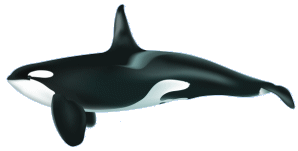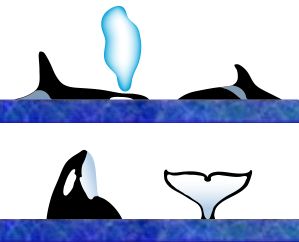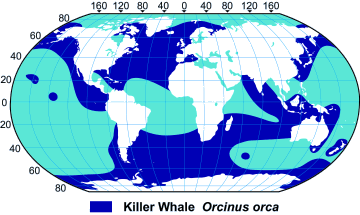KEYWORDS: orca fact sheet killer whale fact sheet odontocete toothed whale largest dolphin facts whale genus species
AUTHOR:
The orca, or killer whale, with its striking black and white coloring, is one of the best known of all the cetaceans. It has been extensively studied in the wild and is often the main attraction at many sea parks and aquaria.
An odontocete, or toothed whale, the orca is known for being a carnivorous, fast and skillful hunter, with a complex social structure and a cosmopolitan distribution (orcas are found in all the oceans of the world). Sometimes called “the wolf of the sea” orca can be a fierce hunter with well-organized hunting techniques, although there are no documented cases of killer whales attacking a human in the wild.
ORCA (Killer Whale)
Orcinus orca
 |
||
|
CLASS: |
Mammalia |
|
| ORDER: | Cetacea | |
| SUBORDER: | Odontoceti | |
| FAMILY: | Delphinidae | |
| GENUS: | Orcinus | |
| SPECIES: | orca | |
PHYSICAL SHAPEThe orca is a stout, streamlined animal. It has a round head that is tapered, with an indistinct beak and straight mouthline. COLORThe orca has a striking color pattern made up of well-defined areas of shiny black and cream or white. The dorsal (top) part of its body is black, with a pale white to gray "saddle" behind the dorsal fin. It has an oval, white eyepatch behind and above each eye. The chin, throat, central length of the ventral (underside) area, and undersides of the tail flukes are white. Each whale can be individually identified by its markings and by the shape of its saddle patch and dorsal fin.
FINS AND FLUKESAnother distinctive feature of the orca is its dorsal fin, which can reach 6 feet (1.8 m) high in males and is shaped like an isosceles triangle. The immature male and the female dorsal fins are also large, reaching 3 feet (.91 m) high, but are falcate (curved). The dorsal fin often has identifying nicks, cuts, scars and indentations. The paddle-shaped pectoral flippers are broad, rounded, and can reach a length of nearly 6 feet (1.8 m) and a width of 3 feet (.91 m). LENGTH AND WEIGHTMales can grow as large as 32 feet (9.6 m) long and weigh 8 to 9 tons. Females can reach 23 feet (8.2 m) in length and weigh up to 4 tons. FEEDINGThe mouth of the orca is large and well adapted for hunting. It has 46 to 50 conical shaped teeth that point slightly backwards and inwards. The upper and lower teeth interlock, which aids in gripping large prey and tearing it into smaller pieces for easier swallowing. Depending on the population and geographic area, the diet of orcas varies. Food preference and availability may have led to the distinct population types, such as resident, transients, and offshores that have been observed/identified in the Pacific Northwest region of the United States and other areas around the world. Generally speaking, transients will feed on a variety of animals including: sea lions, elephant seals, harbor seals, porpoises, squid, sharks, fish, penguins, smaller whales, such as belugas and narwhals and even large baleen whales, such as gray whales. Resident whales tend to feed primarily on fish species such as salmon or herring. The diet of offshores is still being studied by scientists. MATING AND BREEDINGLittle is known about the orca's breeding habits. Newborn calves have been observed throughout the year suggesting that that mating can occur at any time with no particular breeding season. In the wild, orcas become sexually mature between the ages of 10 and 18 years of age and are thought to be actively reproducing by the time the male reaches about 20 feet (5.1 m) in length and the female reaches about 16 feet (4.1 m). Based on long-term field studies, females are believed to be reproductively active into their early 40's. The maximum age for males is unknown. Captive females can bear a calf every two years, but a more typical period between calves in the wild is 3 to 5 years. The gestation period is estimated to be between 13 to 17 months. At birth, a calf is generally about 6-7 feet long (1.8-2.1 m) and weighs around 400 pounds. However, calf size and weight does vary slightly between populations/regions.
DISTRIBUTION AND MIGRATIONThe orca is found in all the oceans of the world, though they are more abundant in cooler waters. Unlike some other species of whales, which follow a regular migration route each year, the orca seems to travel according to the availability of food. They are one of the few species of whales that move freely from hemisphere to hemisphere. BEHAVIOR & NATURAL HISTORYOrcas generally live in pods (groups) consisting of several females, calves, one or more males, and/or juveniles. Some pods consist of a mother and her offspring who stay with her for life. This type of matrilineal family structure has been observed in the U.S. Pacific Northwest where resident pods have been documented as stable, consistent matriarchal family groups with several generations traveling together. Transient pods appear to be more fluid; individuals come and go, groups often contain unrelated females with offspring, offspring do not stay with their mother and pods may form solely as a temporary foraging pack. The social structure of other populations, including offshore orcas, is being studied to document whether certain family groups always stay together or return to each other after periods of time. Mothers are very protective of their calves, and orcas are known to protect and care for sick and injured companions. Sparked by the increase in live capture for aquaria and public concern, scientists have been studying resident pods along the northern Pacific coast of the United States and Canada since 1970. By 1973, photographs were being used to identify individuals based on differences in saddle color pattern, dorsal fin shapes and other identifying marks and scars. Identified orcas have all been numbered and careful records are kept of their re-sightings. Recordings of the sounds made by these orcas have revealed that each pod has its own "dialect." Each pod has some sounds in common with other pods, and other sounds that are unique to its own pod. Through these scientific studies, much has been learned about population, travel patterns, reproduction, behavior and social habits of orcas. POPULATION STATUSAlthough orcas are widely distributed, total world population is still unknown. They have no natural enemies and have not been hunted as much as other whales. Recent studies suggest that a significant threat to orcas, and other marine mammals, may come from man-made chemicals. Yet, toxins are not the only threats facing orcas. Many fish populations around the world are decreasing. This may be having a direct effect on the populations of fish-eating resident whales. Loss of fish may also cause a decline in seals and sea lions, often the primary prey of transient orcas. |
|
FURTHER READING: Want to read more? We recommend these books about whales, dolphins, and porpoises: Baird, Robin W. Killer Whales of the World, Natural History and Conservation. Stillwater, MN.: Voyageur Press, 2002. Ford, John K.B., Graeme M. Ellis, and Kenneth C. Balcomb. Killer Whales: The Natural History and Genealogy of Orcinus Orca in British Columbia and Washington State. B.C.: University of British Columbia, 2000. Ford, John K.B., Graeme M. Ellis. Transients, Mammal-Hunting Killer Whales of British Columbia, Washington and Southeastern Alaska. Perrin, W., B. Würsig, and J.G.M. Thewissen, Eds. Encyclopedia of Marine Mammals. New York, NY: Academic Press, 2002. |
|
SOURCE: This fact sheed is courtesy of the AMERICAN CETACEAN SOCIETY. Fact sheets may be reprinted for educational or scientific purposes. Illustrations courtesy Uko Gorter, Copyright © 2003, All Rights Reserved. |


